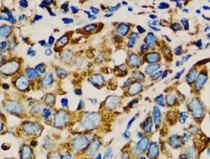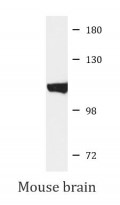ARG40529
anti-OGDH antibody
anti-OGDH antibody for ICC/IF,IHC-Formalin-fixed paraffin-embedded sections,Western blot and Human,Mouse,Rat
Overview
| Product Description | Rabbit Polyclonal antibody recognizes OGDH |
|---|---|
| Tested Reactivity | Hu, Ms, Rat |
| Tested Application | ICC/IF, IHC-P, WB |
| Host | Rabbit |
| Clonality | Polyclonal |
| Isotype | IgG |
| Target Name | OGDH |
| Antigen Species | Human |
| Immunogen | Recombinant fusion protein corresponding to aa. 148-427 of Human OGDH (NP_001003941.1). |
| Conjugation | Un-conjugated |
| Alternate Names | 2-oxoglutarate dehydrogenase complex component E1; EC 1.2.4.2; AKGDH; OGDC-E1; OGDC; 2-oxoglutarate dehydrogenase, mitochondrial; E1k; Alpha-ketoglutarate dehydrogenase |
Application Instructions
| Application Suggestion |
|
||||||||
|---|---|---|---|---|---|---|---|---|---|
| Application Note | * The dilutions indicate recommended starting dilutions and the optimal dilutions or concentrations should be determined by the scientist. | ||||||||
| Positive Control | Mouse brain | ||||||||
| Observed Size | 110 kDa |
Properties
| Form | Liquid |
|---|---|
| Purification | Affinity purified. |
| Buffer | PBS (pH 7.3), 0.02% Sodium azide and 50% Glycerol. |
| Preservative | 0.02% Sodium azide |
| Stabilizer | 50% Glycerol |
| Storage Instruction | For continuous use, store undiluted antibody at 2-8°C for up to a week. For long-term storage, aliquot and store at -20°C. Storage in frost free freezers is not recommended. Avoid repeated freeze/thaw cycles. Suggest spin the vial prior to opening. The antibody solution should be gently mixed before use. |
| Note | For laboratory research only, not for drug, diagnostic or other use. |
Bioinformation
| Database Links | |
|---|---|
| Gene Symbol | OGDH |
| Gene Full Name | oxoglutarate (alpha-ketoglutarate) dehydrogenase (lipoamide) |
| Background | This gene encodes one subunit of the 2-oxoglutarate dehydrogenase complex. This complex catalyzes the overall conversion of 2-oxoglutarate (alpha-ketoglutarate) to succinyl-CoA and CO(2) during the Krebs cycle. The protein is located in the mitochondrial matrix and uses thiamine pyrophosphate as a cofactor. A congenital deficiency in 2-oxoglutarate dehydrogenase activity is believed to lead to hypotonia, metabolic acidosis, and hyperlactatemia. Alternative splicing results in multiple transcript variants encoding distinct isoforms.[provided by RefSeq, Sep 2009] |
| Function | The 2-oxoglutarate dehydrogenase complex catalyzes the overall conversion of 2-oxoglutarate to succinyl-CoA and CO(2). It contains multiple copies of three enzymatic components: 2-oxoglutarate dehydrogenase (E1), dihydrolipoamide succinyltransferase (E2) and lipoamide dehydrogenase (E3). [UniProt] |
| Cellular Localization | Mitochondrion matrix. Nucleus. Note=Mainly localizes in the mitochondrion. A small fraction localizes to the nucleus, where the 2-oxoglutarate dehydrogenase complex is required for histone succinylation. [UniProt] |
| Calculated MW | 116 kDa |
Images (3) Click the Picture to Zoom In
-
ARG40529 anti-OGDH antibody ICC/IF image
Immunofluorescence: U2OS cells stained with ARG40529 anti-OGDH antibody.
-
ARG40529 anti-OGDH antibody IHC-P image
Immunohistochemistry: Paraffin-embedded Human lung cancer tissue stained with ARG40529 anti-OGDH antibody at 1:100 dilution.
-
ARG40529 anti-OGDH antibody WB image
Western blot: 25 µg of Mouse brain lysate stained with ARG40529 anti-OGDH antibody at 1:1000 dilution.
Specific References










